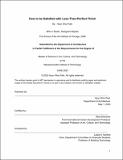| dc.contributor.advisor | Sinnokrot, Nida | |
| dc.contributor.author | Park, Hyun Woo | |
| dc.date.accessioned | 2023-11-30T21:43:13Z | |
| dc.date.available | 2023-11-30T21:43:13Z | |
| dc.date.issued | 2023-06 | |
| dc.date.submitted | 2023-07-13T21:28:12.603Z | |
| dc.identifier.uri | https://hdl.handle.net/1721.1/153101 | |
| dc.description.abstract | Contemporary (Western) society runs on the ideology of projected continuous growth. Capital works as food for growth, by placing the virtue on the constant and focused effort of production, followed by consumption. Creative industries such as the art and design field are not an exception. But in recent years it has become more and more clear that continued economic stability will not be possible at least with the same mode of operation in making things. It is more relevant than ever to look for new approaches in engaging the practice of creative making. How can one engage in the practice of creative making in the precarious world of current era?
In this paper, I navigate through various activities that I performed while at MIT and weave through them in a methodology of embracing contingency, precarity, and friction to demonstrate a novel way of creative making practice with materiality and material agency becoming an active player within the practice.
I reevaluate the preconceived notion of material-based art and design, as well as the common practice of relentless production of novel objects in negligence of their object or material agency. The methodology of reappropriating material and the way of its fabrication unfolds in an exploratory manner, unsurprisingly often with a novel approach of precarious, ad-hoc, and even seemingly haphazard ways.
Additionally, this paper will be in such fashion as a logbook and should serve as a reference for the future self and art and design practitioners alike. I propose that the questions and trials that this paper presents would be to help for someone who hopes to escape from the immobilization by the feeling of their own practice going nowhere from the very practice that they have carried on. | |
| dc.publisher | Massachusetts Institute of Technology | |
| dc.rights | In Copyright - Educational Use Permitted | |
| dc.rights | Copyright retained by author(s) | |
| dc.rights.uri | https://rightsstatements.org/page/InC-EDU/1.0/ | |
| dc.title | How to be Satisfied with Less-Than-Perfect Finish | |
| dc.type | Thesis | |
| dc.description.degree | S.M. | |
| dc.contributor.department | Massachusetts Institute of Technology. Department of Architecture | |
| mit.thesis.degree | Master | |
| thesis.degree.name | Master of Science in Art, Culture and Technology | |
